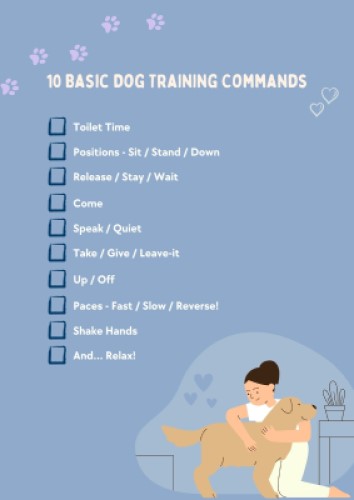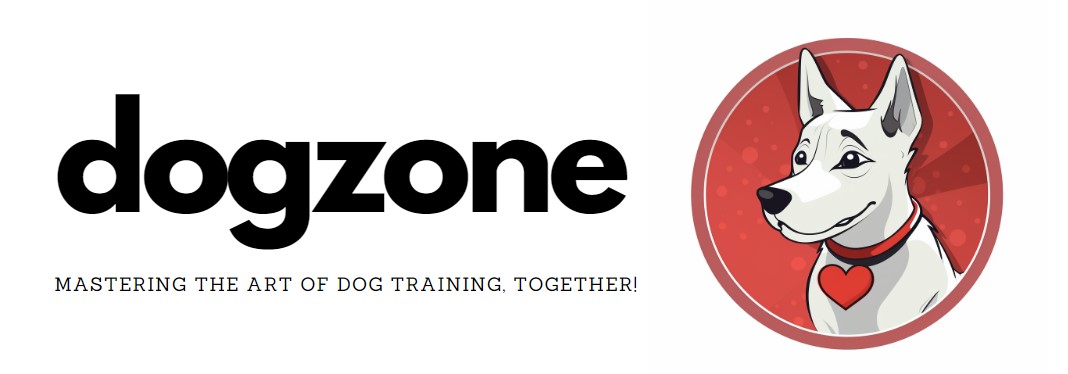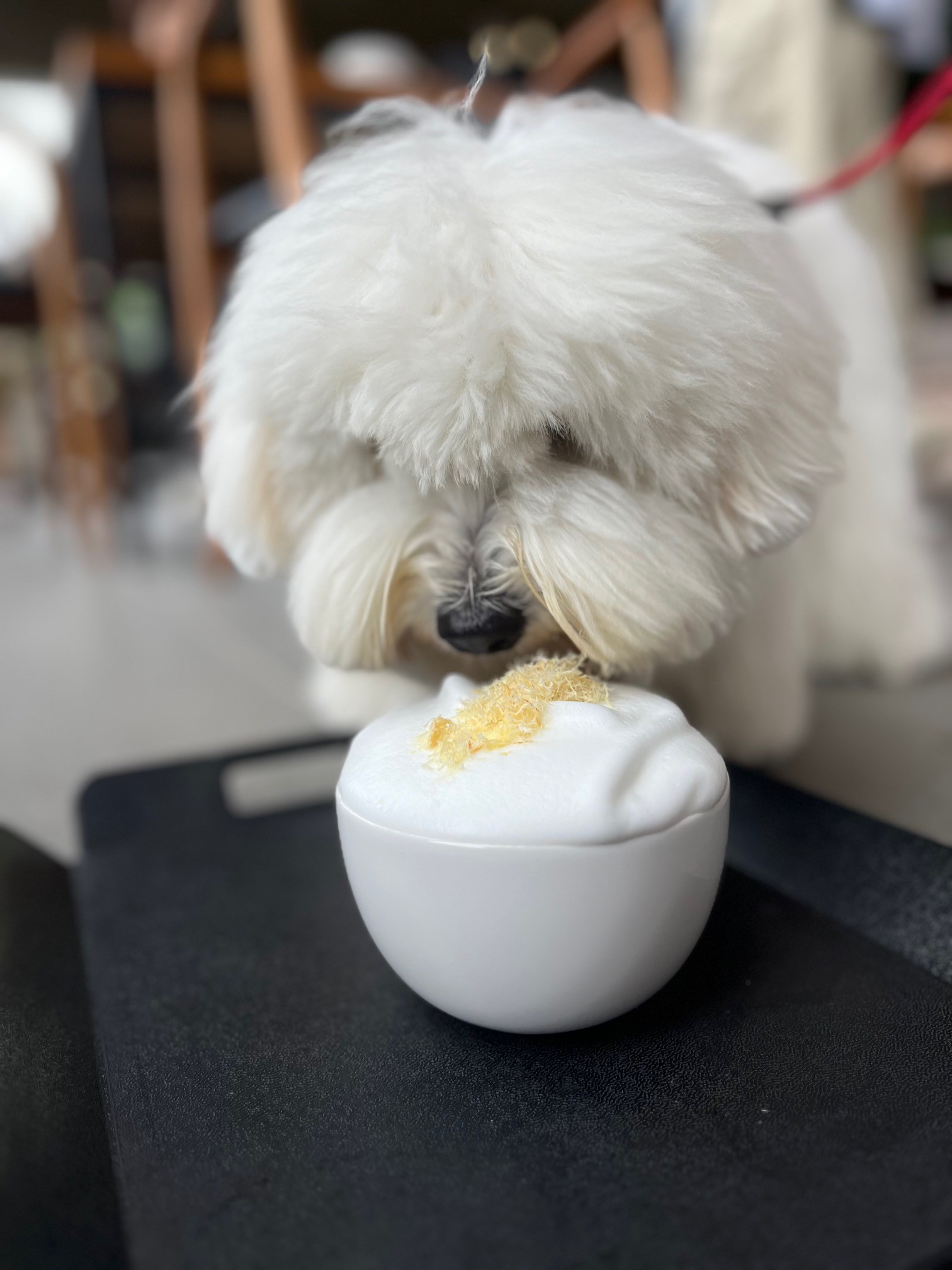Part of: New Puppy: A Complete Guide to Puppy Training!
You’re up for a challenge, aren’t you?
In this guide I’ll get you and your pup up and running with the 10 basic dog training commands. These commands are essential in turning your dog into an awesome sidekick!
10 Basic Dog Training Commands Checklist
Training doesn’t happen over night, so here’s a handy checklist for you to print out or share. Consider it your mission over the coming weeks!

Basic Command #1: Toilet Time
The first and most urgent command to teach your puppy is to toilet in front of you.
Use context cues such as popping the puppy on a lead and taking him to your chosen spot in the garden.
Use a phrase that you won’t be embarrassed to say in public such as “hurry up”.
You may start with saying your cue “hurry up” only while the puppy is peeing. Then slowly, move the cue forward to when the puppy sniffs or circles – usually precursors to squatting and peeing.
When your puppy has finished it’s vital he is rewarded with praise and – if you want the training to go as fast as possible – a treat.
Eventually, simply getting out the lead and heading for the garden with your cue words should be ample information to produce a toileting response.
This is fantastic because now you know you can toilet your dog before you leave for work, or bedtime or a car trip. It puts you in control of the when and where of toileting.
Basic Command #2: Positions – Sit / Stand / Down
Position changes are like the ABC’s of dog training.
Although you can achieve a reasonable level of control over your dog just by having a reliable “sit” – teaching “stand” and “down” gives you a greater variety of options and will make training more interesting for both of you. With three options your dog cannot predict which position will be next – really testing whether or not he understands the three different concepts.
Ideally, your dog should respond to your word and/or hand signal both by your side, from in front and at a distance. Positions are most easily taught using a food lure.
Here’s some tips on how to conquer these command:
- To teach “sit” slowly move a small treat above your dog’s head as the head goes up, the bottom will come down and ‘sit’ happens.
- For “stand” – draw the treat straight forward from the dog’s nose level. This will become the hand signal for ‘stand’.
- For “drop” – take the treat toward the floor between the dog’s toes. This will become the hand signal for ‘drop’.
- Remove the treat from your hand after about three repetitions and repeat using the exact same hand movement . This will soon become your visual command or signal for your dog to sit, stand or drop.
- When your dog is responding to the signal, add the word just before the hand signal.
- Reward AFTER each correct response sometimes use food sometime just praise.
Bonus Training: Adding Distance
For an extra dog training challenge work on position changes at a distance. Distance work provides extra control and safety whenever your dog is off lead.
Imagine your dog running toward a road – a distant “drop” command stops him in his tracks.
If you want your dog to be a TV star then distance work is essential! Distance work is where trainers have to be able to cue their dogs from behind the cameras. But if TV seems too far fetched, it will also help you take cool staged pictures of your dog for #instagram!
Start by leaving your dog in a stand and moving away just a few feet, turn and signal the drop or sit. Sometimes leaving your dog in a restricted spot such as a stair landing or table will prevent the dog from creeping toward you.
Generously reward every correct response and soon you will have a dog that will happily sit or drop at any distance!
Basic Command #3: Release / Stay / Wait
“Release” is probably the most under-rated command in dog training.
You must be sure to teach your dog that every behaviour has a beginning AND an end. Too often people ask their dog’s to sit but forget to tell them to “unsit”. The end result is – if you are unreliable, your dog will also be unreliable.
Let’s consider this a little further…
The first command tells the dog to start doing something, then the release command tells him to stop doing it.
Common release words are “free”, “off you go”, “playtime” and “o.k.”
“Stay” adds a new criteria – it informs your dog you are now moving away and he is to stay.
- Place an open hand in front of the dog’s face, say “stay” and move just a step away.
- Slowly increase the distance and time away.
- Always come back to release your dog. This will prevent creating a dog who anxiously watches for a release signal the whole time you are away.
“Stay” should mean stay put until you return. Only your return will cue your dog that he will soon be released.
“Wait” is for a temporary pause or stay. It suggests your dog remains attentive because in a moment he’ll be asked to do something such as “come”, “fetch” or “follow”.
Many people use a different hand signal for “wait” and “stay”. You may find a natural hand signal which works best for you, and as long as you remain consistent it will work.
Think carefully about what you want each of these terms to mean before you start to train your dog.
Basic Command #4: Come
“Come” is obviously one of the most important commands to teach your dog, but you may be surprised it’s the one most people have trouble with?
Most people will get a new dog and immediately start calling “come”, but it doesn’t work if you haven’t taught him what the command means. You may just as well be saying “26! 26!”
“Come” can be described as either a direct movement toward you or a position close to you. If your dog is running directly toward you say “come” to associate the word with that behaviour. You’ll have much better results using this method of teaching your dog the command.
Remember you need to reward your dog to encourage him to repeat this behaviour.
Use a light long line and do lot’s of practices of ‘come’ and reward. When you have set the dog up for success – “coming” when called will eventually become a habit.
Basic Command #5: Speak / Quiet
“Speak” and “quiet” should always be taught at the same time – after all it’s really just the “on” and “off” switch for the same behaviour!
Most dog’s will bark at predictable times, such as when someone arrives at the door. Say “speak!” (or whatever word you might like to use) and praise/reward your dog.
Follow this with “Quiet” and immediately reward with several treats in succession.
Reward either the “speak” or the “quiet” more heavily – depending on which your dog finds harder, or which is more important to you.
By labeling both these behaviours you have a better chance of keeping your dog’s volume under your control – sounds good, doesn’t it?
Note that choosing a different word for “speak” such as “alert” will make no difference to
your dog, but will change the perception of your dog’s barking to other people, so choose your command carefully.
Basic Command #6: Take / Give / Leave-it
These three commands train your dog in taking, releasing, or ignoring an object. You’ll find the latter useful when your dog finds some dodgy looking food on the pavement.
“Take” means you are giving your dog permission to put an object into his mouth – such as a piece of food, dinner, or a toy. This command can be taught right from when you start rewarding your puppy with food treats – precede the release of the treat with “take”.
The “take” command is really useful if you have young children who are likely to run around the house with food at dog-eye level. It will help prevent your puppy from opportunity grabbing (and having an upset child!)
This command can also be a great way to start teaching your dog to retrieve by encouraging them to take a ball into his mouth. Follow this with “Give“, which means the release of the treat or toy.
I’m sure you want to play games with your dog, and all games need rules. It’s a good idea to teach your dog that in most cases the command “give” results in either a food treat or the continuing of a game. If your dog doesn’t give, then he must learn this behaviour results in the end of game.
Tug is a great game to play with most dogs, but only provided they’ve learnt to “take” and “give” reliably on command.
“Leave-it” commonly means ignore that and look at me instead. This is a very useful command and may prevent the dog ingesting something harmful such as chicken bones or even baits. Anyone who’s owned a dog for a period of time will tell you how quickly a dog will devour something potentially unsafe in less than a second.
Practice the “leave it” command at home, and use a really good reward from your own hand.
You can extend this exercise to prevent your dog taking food from other people too by doing lots of practices with friends and visitors.
It’s impressive when you can put a raw meaty bone in front of your dog and say “leave it”, and he’ll sit there patiently in anticipation of his reward. That’s when you know you’ve nailed it!
Basic Command #7: Up / Off
“Up” and “Off” are general control commands to help move your dog around. “Up” can be permission to come onto the furniture, into the car, onto the grooming table or even jump into your arms.
At the same time you will need to train the opposite command “off” – to remove your dog from such places.
Again, reward the more difficult or more important part of this exercise more heavily.
For some dogs and owners this may be getting “off” the furniture, and for others it may be getting “up” into the car. If you’ve been to Bali, then “up” may even mean getting onto the moped.
Basic Command #8: Paces – Fast / Slow / Reverse!
Your dog will walk better on a lead if you teach him cues for walking slowly and quickly.
This sounds tricky, but you’ll find it’s surprisingly easy to do and a great way to show off your dog.
All you need to do is have your dog on a lead and as you speed up say “quickly!” To slow up -exaggerate a little and as you say “steady”, then creep along as if you’re sneaking into your house late at night.
Dogs will really enjoy responding to your changing body language as you play this fun game.
Say “quickly” in a slightly higher, more excited voice. Then say “steady” with a lower, slower tone. These sounds have been found to be universal in speeding up and slowing down lots of domestic animals!
(Try it on your cat too – if you like impossible tasks)
Another aspect to the Fast / Slow commands is adding “Reverse” or “back”. You can consider this mastery of Basic Command #8!
“Reverse” can be really useful in tight situations such as doorways where you may need your dog to step back.
You can teach the command in many ways, but the main thing is to be on the look-out for when your dog naturally steps back.
For many dogs this is when you hold a toy, or if you gently walk into your dog as he stands in front of you – be ready to label the step back with the word “back” or “reverse” and follow with a reward.
Timing is everything, but I’m sure you have plenty of time to practice!
Basic Command #9: Shake Hands
“Shake Hands” has to be the most famous of dog tricks, but it’s also a really useful command for several reasons.
For starters, it’s such a fun way to make your dog appear smart, well trained, and friendly – especially to children. If you have kids, it’s hands down the cutest way to impress their friends.
It’s a very useful command for general care such as cutting nails or checking pads for cuts or ticks.
Shake hands is also a good way for shy dogs to greet strangers, rather than the stranger having to reach over their head for a pat which is far more threatening. So if your dog is shy then this can turn greeting new people into a fun game.
Many dogs – notably Terriers – will lift their paw to get a treat within a few seconds of the treat appearing.
Other dogs are much less inclined to use their feet, so if this is your dog then persevere and be creative. Ask your dog to climb onto your lap, then reward the moment the first paw is lifted. Your hand reaching down is the most common cue for this behaviour to which you can add “shake!”
Practice will make perfect with the “shake hands” command, but remember it’s the reward more than the word which will make training successful.
Basic Command #10: Relax
It’s important to relax, so it’s a great idea to put a label or “cue” on the sensation of relaxation.
This may sound silly at first but it’s so easy to do and the benefits can be wonderful. It may inspire to try teaching the command to your partner as well, but that can prove a harder task.
First I’ll teach you how to succeed with the “relax” command. It gets a bit corny, but keep reading as you’ll be surprised at how beneficial this command will be.
Make a mental note to teach this command after you’ve taken your dog for a long walk or after their dinner. It’s after these events your dog will naturally want to rest.
Whenever your dog begins to settle down give him the command “relax”. You can reinforce the command with a doggy massage – I know it sounds silly but it works, and who doesn’t like giving their dog a little massage?
Some dog owners will use other context cues such as soft music or scented candles. This really is pamper-the-pooch to the max, but what you are doing is classically conditioning these cues with relaxation.
At this point you may think my training advice is a little too much, so let’s consider why “relax” is such a useful command.
There will come times when you need to cut your dog’s nails, search them for a tick, put eye drops in their eyes, clean out the ears, or sort out painful knots in his coat. Most dogs get anxious during these times which makes it very frustrating for you as their owner.
However, using the “relax” command, along with music and scent cues, means your dog will stop any struggling and relax.
The wilder and more difficult to handle a dog, the greater benefits can be from teaching him to relax on command. If you are able to use the command really well, it can even be used to some benefit when out and about should you come across something which distresses him. This can be loud noises (including fireworks) or a scary dog.
Every dog is smart enough to learn these 10 Basic Dog Training Commands, but the most important thing of all is you both enjoy the journey.
Are you up for the task? Make sure you print out the checklist and take on the challenge!
Let me know how you get on in the comments!



Leave a Reply